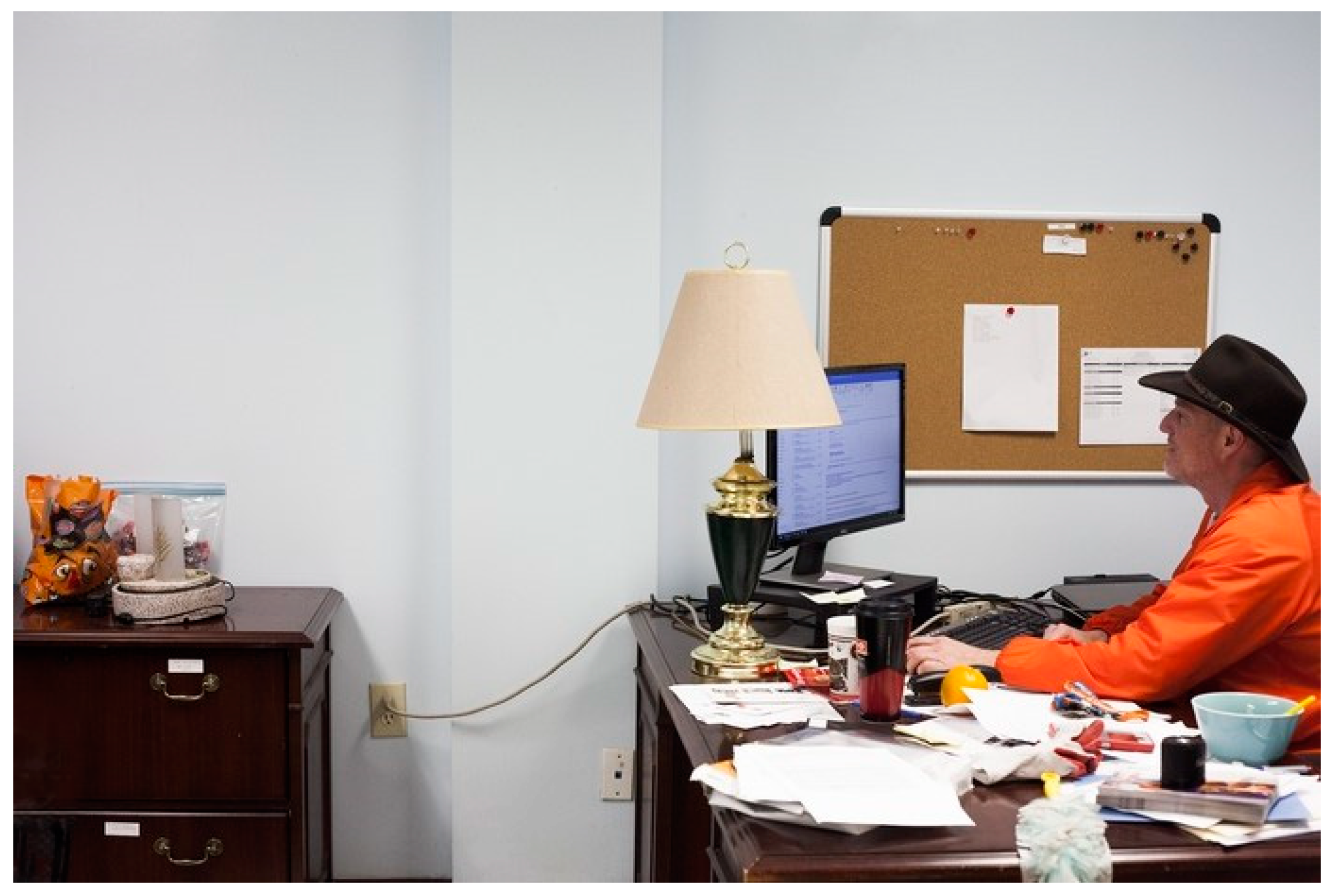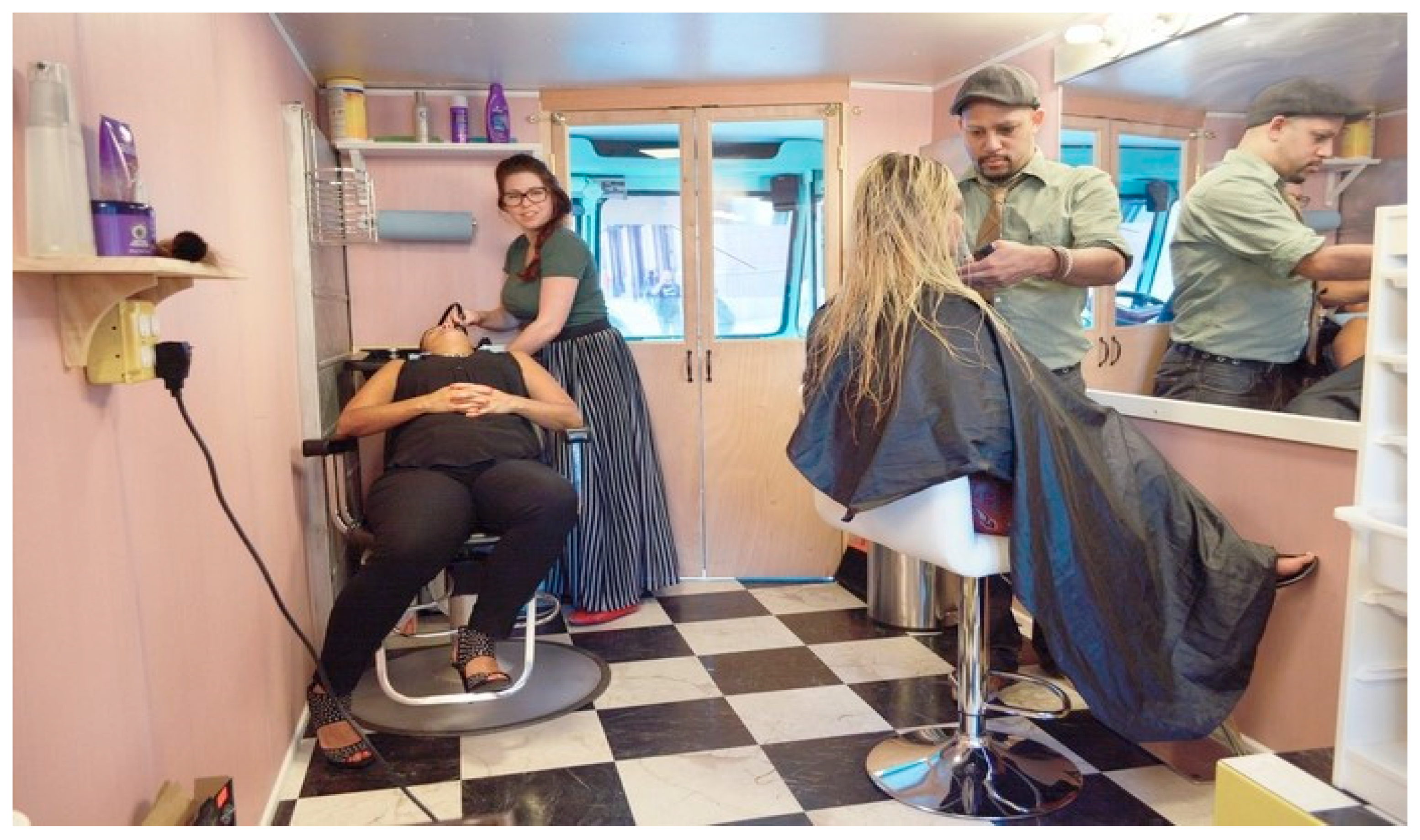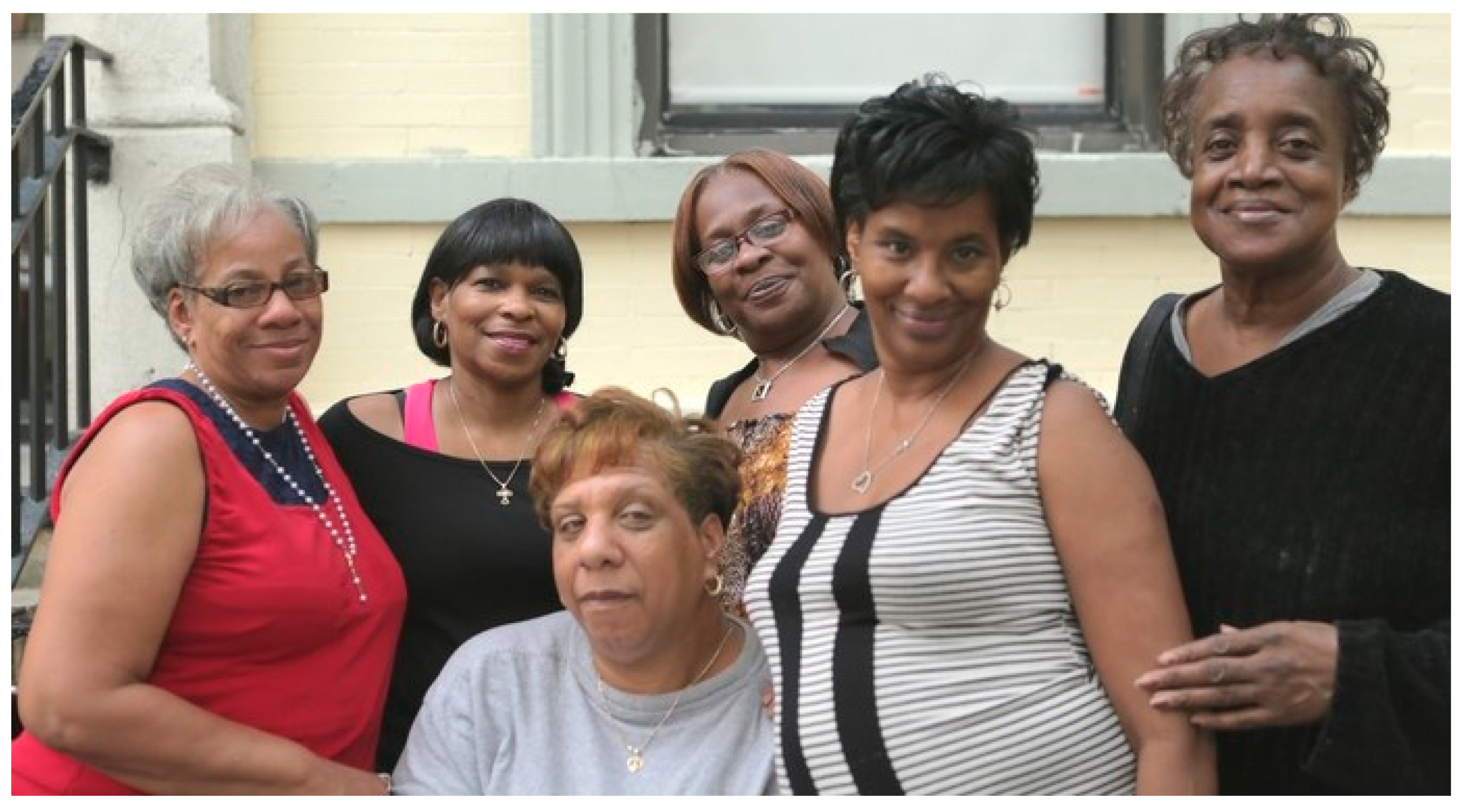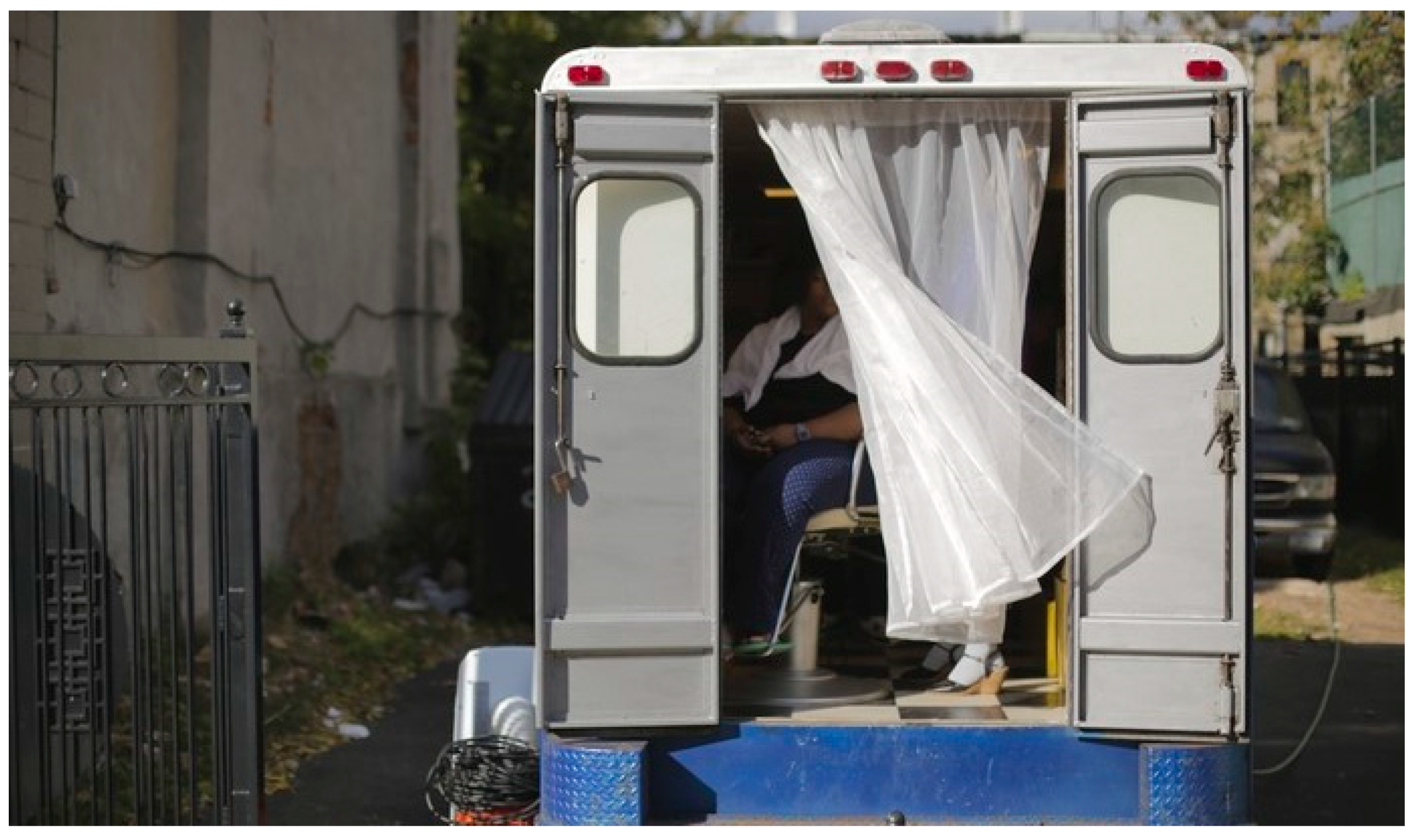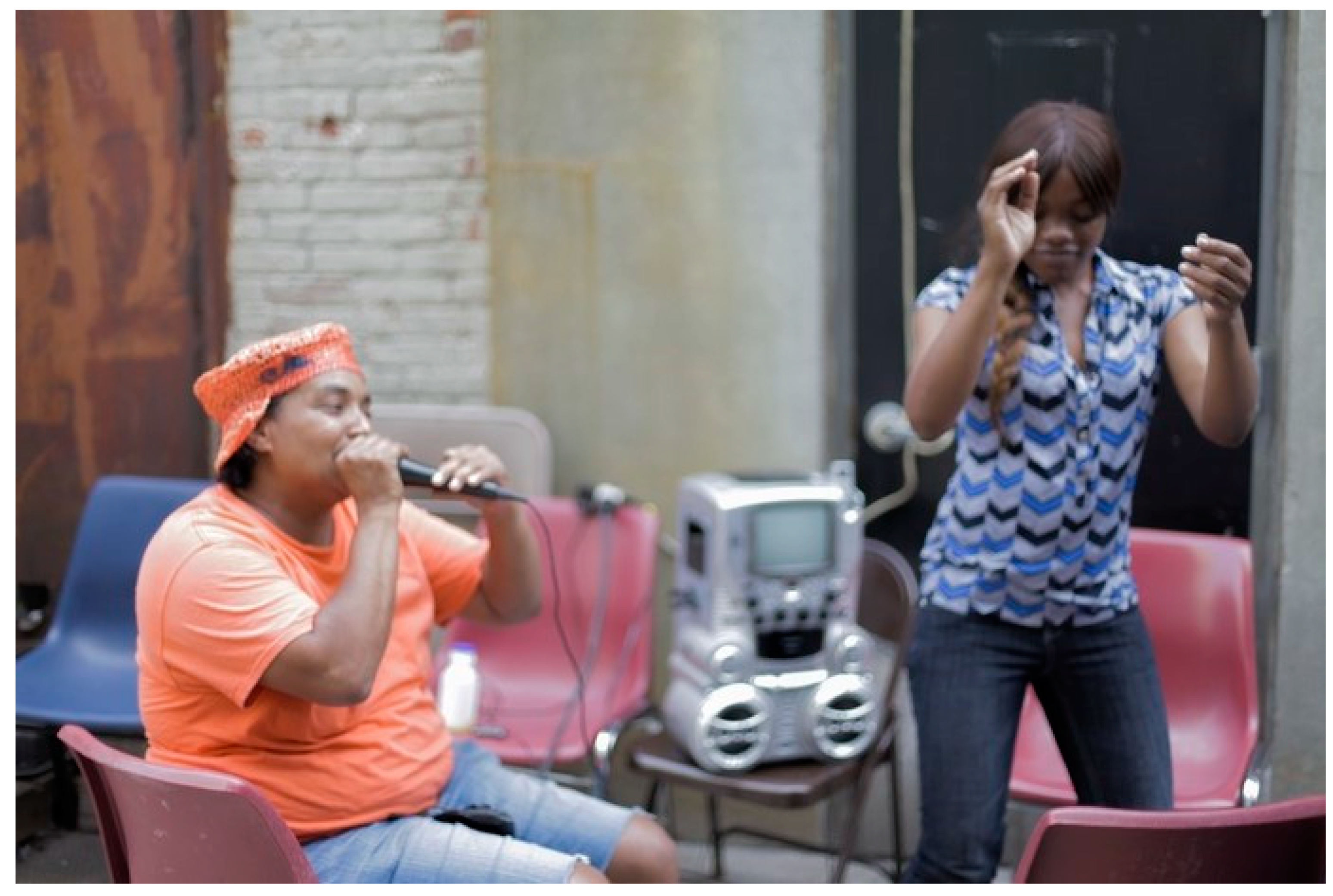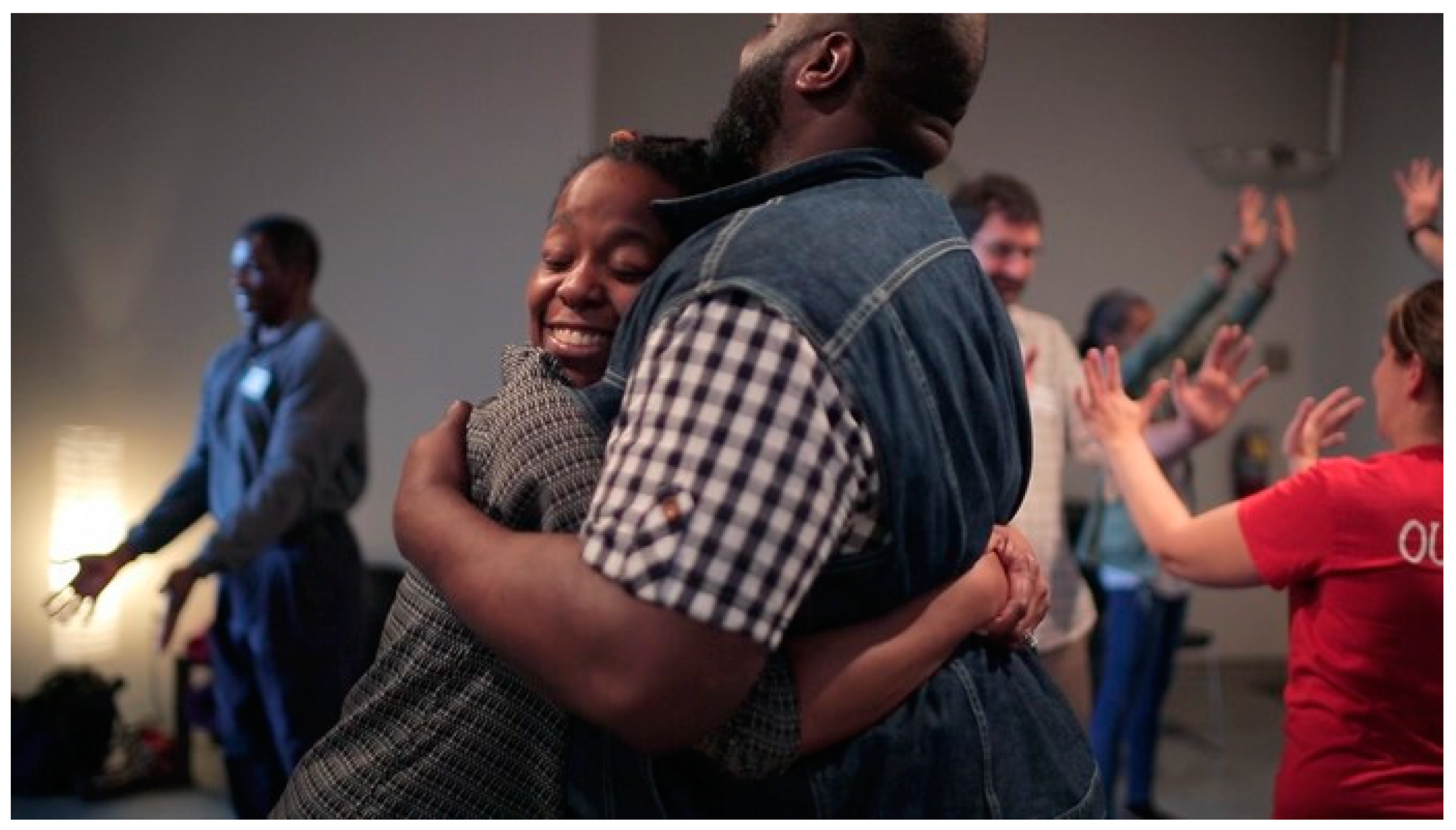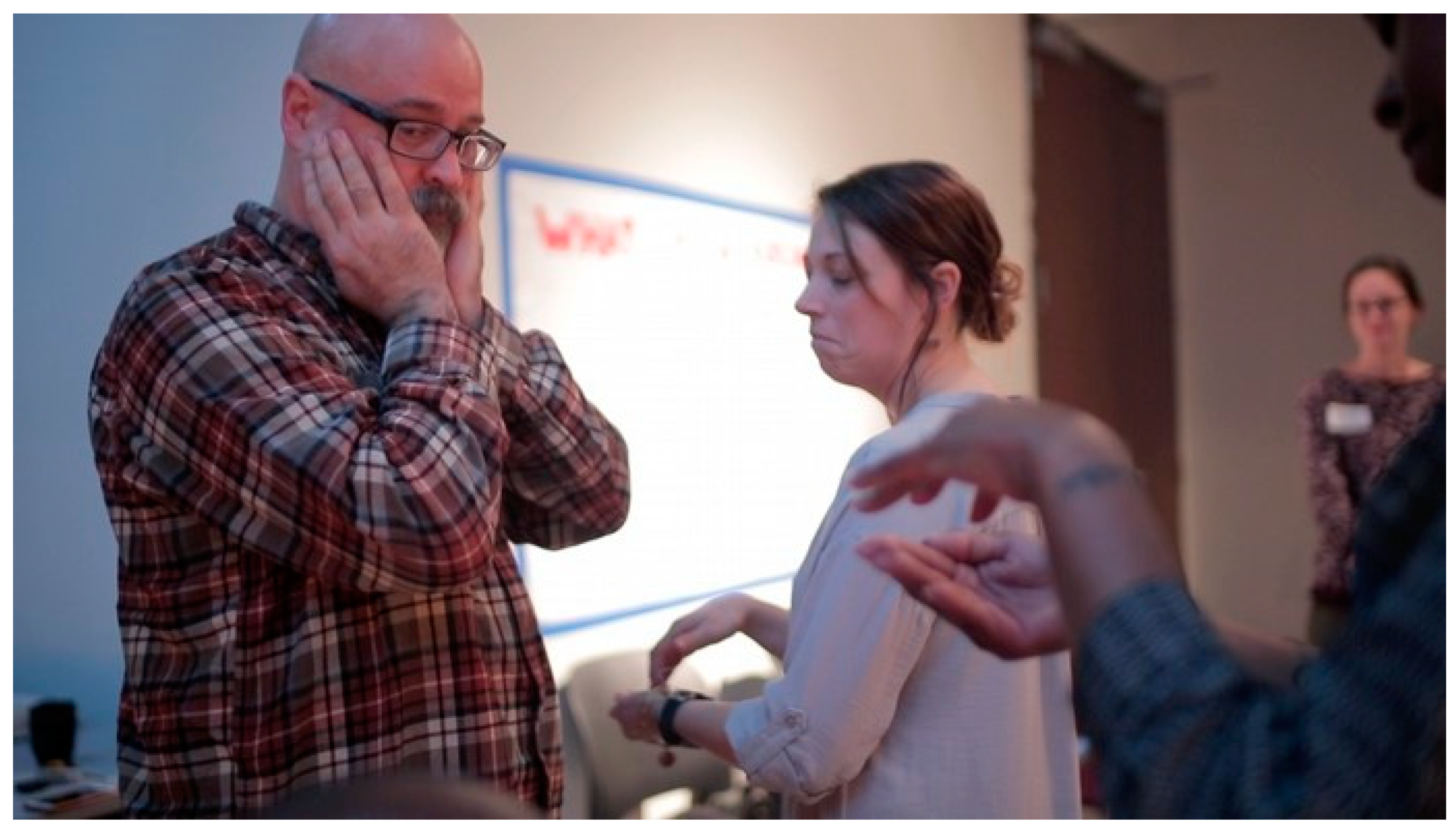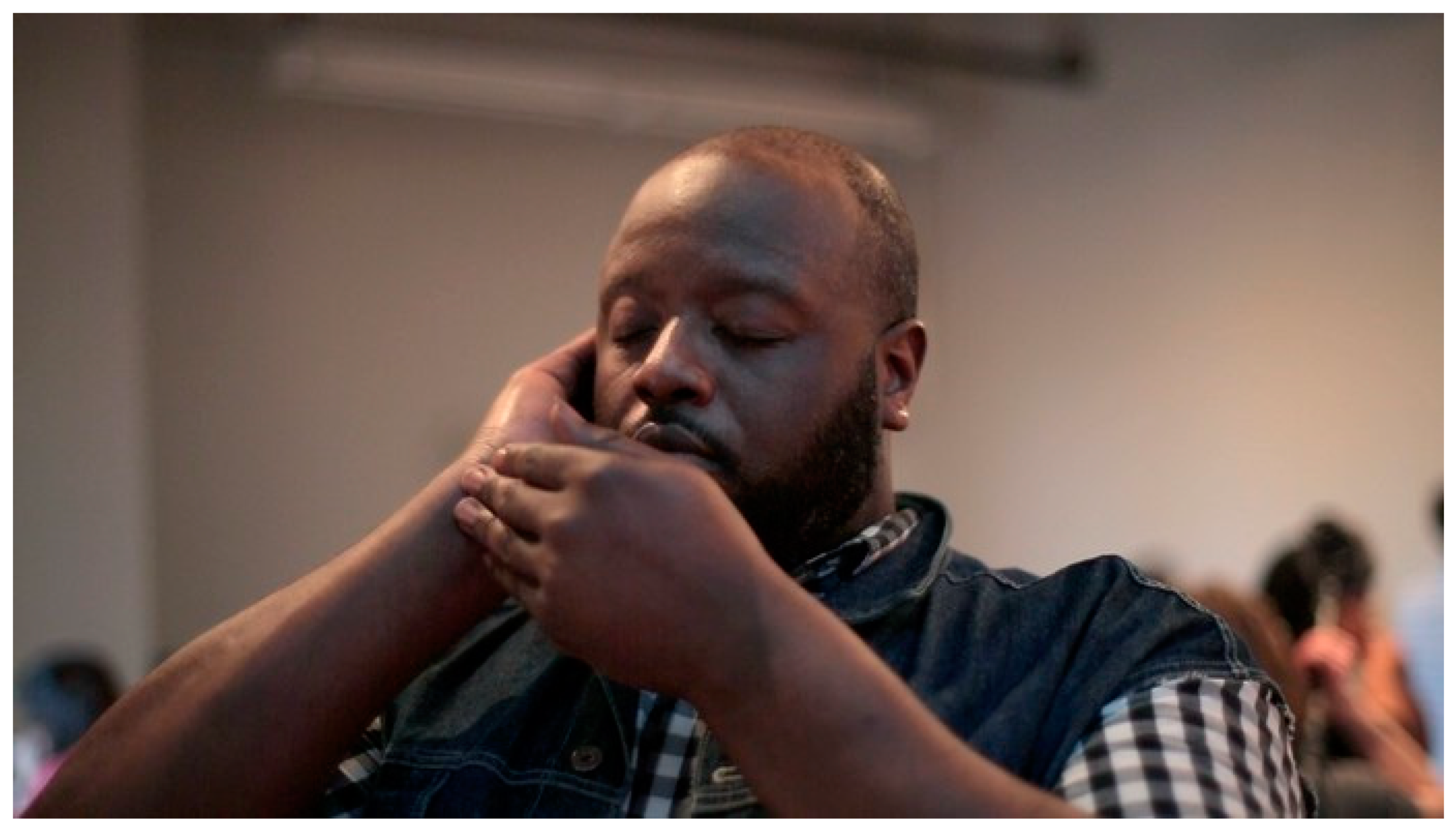2.1. Social Context of Homelessness
I once walked past a shop owner in Brooklyn who was furious, yelling because someone had stolen one of her tall potted plants displayed on the sidewalk. “A homeless person stole my plant”, she yelled to anyone walking by, “It must have been some homeless person!” Passersby were nodding sympathetically to avoid the shop owner’s wrath. The incongruity of imagining a person who does not have a home stealing a huge potted houseplant was overlooked in the commotion. Misplaced outrage, such as the shop owner’s, commonly plagues people experiencing homelessness. If you tune in, before long you might overhear someone asserting that a mysterious illness can be traced back to proximity with a homeless person, or an unseen attacker who, despite not being witnessed, was likely one of the homeless people in the area. The seemingly trivial incident of a stolen plant underwrites a pervasive truth: the impoverished and homeless are among society’s invisible, nameless scapegoats. The danger assigned to those who are poor speaks to people’s deep fears of their own vulnerability, especially in America where independence and economic self-sufficiency are heralded as our highest values. Instead of hardening into stigmas, how can entrenched fears of vulnerability shift to service a more caring society? To explore a possible connection between vulnerability and social intimacy, I created first
Beauty in Transition (2013–2016), followed by
Choreographing Care (2016–2018). Both works address dignity and care within the transition of losing one’s home and being rehoused, a process often aided by municipal homeless service agencies (
Figure 1).
Beauty in Transition focuses on clients of these services and
Choreographing Care focuses on staff. Both projects are positioned within the framework of social art and exhibit a public component in hopes of illuminating some of the less obvious conditions of homelessness to people such as that shop owner and her bystanders.
2.2. Shelter Is Not a Home
When the label of ‘homeless’ is invoked, people commonly think of those who sleep rough on the streets or in train cars. While these may be the most visible examples of homelessness, they are the minority. The great majority of people use temporary transitional housing facilities such as emergency overnight shelters, wherein social workers lead efforts to navigate complex bureaucratic systems to regain housing for each client (
Figure 1 and
Figure 2).
In the United States, unless a shelter is run by a religious organization, they are funded and mandated by a city oversight agency and managed individually by nonprofit organizations.
1 This paper focuses on the latter. To keep order within an overcrowded environment, clients must abide by shelter rules with the threat that not doing so could lead to forfeiture of one’s bed. Being inside by curfew, keeping bunk areas clean, signing out for smoke breaks, and meeting with case workers are some of the mandates one must agree upon to enter the shelter system. The New York City oversight agency, the Department of Homeless Services, advises clients not to become too comfortable in these temporary dwellings, stating in their client code of conduct, “Since shelter is not a home, but rather a steppingstone to permanent housing and rejoining the community, there are certain expectations for you while in shelter” (
NYC DHS 2009, p. 35). As stated here, participating in a community outside the shelter is paused until housing is regained. Being only temporary, homeless shelters occupy a purgatorial space between where one was and where one ought to be. Temporary spaces are usually not meant to be comfortable, and even less so when the occupants therein are poor. However, when a lack of affordable housing means homelessness can last six months or longer, and when staff occupy those same temporary spaces year after year, might we need to change those expectations of discomfort? Likewise, even though the condition of homelessness is temporary, is social inclusion not a human need?
The totalizing aspect of these institutions is that staff and clients alike are subject to rules and mandates controlled by an external authority (
Goffman 1961). They do not have a lot of independence and are ostracized by the general public. In these restrictive environments, work can become a drudgery. The self-protective coping mechanisms staff use to just get through the day may become entrenched habits that promote passivity rather than empowerment to affect difficult situations. For example, when I asked a front desk staffer at a North Carolina shelter how he felt when he had to turn people away when the shelter was full, he gestured to a script he followed and told me he was thankful there is a script for every scenario so he did not have to think about it.
2How can some of these habits be reflected upon through the vehicle of social art without disrupting the operational efficiency of homeless service agencies? Along with considering ways to shift experiences inside homeless service agencies, I have considered the reasons why I ought to, and what I could hope to achieve as an outsider with temporary projects. I did not wish to temporarily make homelessness more tolerable for the sake of asserting it should simply be a pleasant experience. Instead, I wished to shift perceptions about self-worth and dignity in opposition to dominant cultural values. I also surmised that any way of relieving pressure on staff and clients while they navigate through the challenges of homelessness could be beneficial, even if done through temporary care-based gestures.
The gesture of care through social art practice is not a one-way paternalistic service; care embodies an ethics of equality and is a tool to build connective networks toward that goal. In her monograph
The Ethic of Care, Carol
Gilligan (
2013) points out that within a patriarchal society, care is a feminist ethic that approaches justice through a relational, nonhierarchical, and anti-oppressive framework. She asserts that care and justice are synergistic and the ability to resist injustice is restored through the capacity to empathize. For this reason, positioning care at the center of a social art intervention is not about creating a frivolous feel-good moment; rather, it addresses equality through intangible and relational methodologies. In my practice, I use a relational approach to establish mutual connections across cultural and class divisions. I aim to create conditions for relationships born of solidarity and mutual support. This method is supported by Gilligan’s theory that resistance to injustice requires solidarity between those who are experiencing the negative effects of injustice and those who are not.
2.3. Beauty in Transition
Beauty in Transition was a mobile hair salon on wheels providing free haircare to those living in temporary housing (
Figure 3). The project aimed to break down social stigmas that keep people who are homeless isolated and raise questions about maintaining dignity in addition to basic sustenance-level human needs within state-assisted programs. Partnering with a range of transitional housing agencies such as prison-re-entry housing, emergency overnight shelters, and day centers for LGBTQA youth from NYC to Denver, Colorado, the project focused specifically on the condition of homelessness notwithstanding its cause. A salon that moves from place to place offers the flexibility that is demanded by a transitory situation, as well as a private, safe space on sheltered grounds that can allow the label of homelessness to dissolve. I secured professional hair stylists from top rated salons to volunteer styling services that emphasized a luxurious experience. A few of the stylists shared that the project brought them into a position to aid a community they were once part of. In addition, several residents in transitional housing had studied cosmetology and became service providers with
Beauty in Transition. Consequently, shelter residents participated by either giving or receiving haircare, or as bystanders around the salon while it operated. At a glance, you would not be able to separate who was homeless from who was not. The project was evaluated externally by Jan Cohen-Cruz, Ph.D., whose report (
Cohen-Cruz 2015) I will reference at times below.
2.6. Scope and Scale
Regarding the question of sustaining
Beauty in Transition as a regularly expected service, one resident of a shelter said, “Consistency is a big deal in the shelter; there’s so much we can’t control. If we could know this truck was coming every other week, say, it would be terrific. Also if you look good you feel better. You have a better sense of yourself—that you are worth doing this for”.
3 For despite the project’s momentary value felt by some residents, hair grows out, color fades, split ends return.
How would one repeat those moments of care in perpetuity and extend the timeframe in which they could happen? In New York City alone, if Beauty in Transition went only every other week to the over 600 shelters in the city, we would need a fleet of approximately 44 mobile salons all running 7 days of the week. Even at that scale, we would only be able to administer haircare to a small percentage of clients at each shelter. In the face of these numbers, it is difficult to see the small gesture of doing hair out of a mobile salon as anything but temporary. Aside from the question of feasibility and scale, maintaining Beauty in Transition as a regular service would lose part of what gave the project value.
There is a special charge of novelty that social art can bring into spaces where it is not expected.
Beauty in Transition was a strange sight to behold—it took the form of a nondescript, industrial truck that opened into a small, handmade salon with tiled flooring and wooden walls stained dusty rose. It was complete with a hair washing station and two comfortable chairs for styling that some referred to as a ‘dollhouse’. A potted plant was hanging on the door, and wispy sheer curtains opened at the back of the truck so the salon ‘breathed’ (
Figure 6).
Even outside the truck there was a charge in the air. While awaiting their appointments or waiting for the newly coifed to emerge, sometimes people would spontaneously sing, or start an impromptu dance party outside. Once, a karaoke machine materialized and a singing party ensued (
Figure 7). A director of a Manhattan shelter compared the experience to seeing fireworks: “This was their fourth of July. They were playful with each other which was not typical since they do not usually have the opportunity”.
4 I surmise that part of the reason for this energetic charge was specifically due to the knowledge that the truck was new, unexpected, and temporary. Consequently, I concluded that instead of repeating the same project as a sustainable initiative, it would be more vital to continue intervening in homeless service agencies with different projects. That way, the power of the unexpected could be retained and different aspects that
Beauty in Transition missed could be addressed. While clients come and go from transitional housing, staff remain there longer, and I wondered if a project that addressed their experience could shift the social dynamics at the shelter longer term and lead to systemic change.
2.7. Choreographing Care
My next project,
Choreographing Care, focused on staff at homeless service agencies and imagined what it would look like to sustain their emotional health in this high-pressure, under-resourced environment (
Mullen and Leginski 2010) (
Figure 8).
Choreographing Care took the form of an open workshop series for staff to process and transform stress and secondary trauma using somatic exercises rooted in theater, nonverbal communication, and performance art. Staff who participated were asked to explore thorny subjects related to their work such as the role of touch, power dynamics, and self-agency through body work and discussion. We drew upon Theater of the Oppressed, a series of methods that Augusto Boal began developing in the 1960s, especially his Image Theatre technique, which use theater to collectively address shared problems, along with other established community-based debriefing techniques (
Boal 1979). Just as important as the methods we used was the role of agency buy-in. After much maneuvering with management, the workshops were scheduled during working hours as a paid part of the workday. This helped build a case for supportive ways institutions can facilitate active processes of self-care for their overburdened staff without adding an extra obligation to staff in their off time.
I first launched
Choreographing Care in various locations in New York. Between August 2017 and May 2018, I worked with staff at two homeless service agencies, and then launched the most complete version of
Choreographing Care in Charlotte, North Carolina (
Figure 8,
Figure 9 and
Figure 10). These agencies allowed me to sit in on staff meetings, interview staff, and attend their training sessions. I initiated the workshops after conducting small-group forums with front line staff so that staff concerns directly informed workshop content. Evaluator Jacqueline Larson, Ph.D. candidate in Health Psychology at UNC Charlotte, collected anonymous participant responses. I pulled the excerpts that follow from her report (
Larson 2018).
2.8. Unexpected Perception Shifts
I brought in guests from different artistic fields including music and theater to lead workshops on specific topics that I developed with feedback from staff. In addition, I facilitated, debriefed, and led some of the workshop exercises myself. Like Beauty in Transition, this was not meant to be a one-way service. One social worker based in Charlotte, NC, Heather Bartlett, also practiced theater, and was a tremendous workshop leader for multiple shelter staff including at her own agency.
One of our workshop leaders, Tiffany Borgelin, is a vocal wellness instructor in Charlotte, NC, and certified crisis intervention counselor. She led workshop exercises in Charlotte on self-agency through voice. In one exercise, she guided staff to create a self-amplifying microphone with their hands and speak a desire out loud to themselves. Through this tactile exercise demonstrating intimacy with oneself, participants could hear their own voice amplified through their cupped hands (
Figure 10). One staff later shared their thoughts provoked by the simple exercise despite their initial hesitance to participate in the project:
In that first day, that thing where we did our hands and we talked to ourselves [about what we want]. That was so powerful… I wasn’t expecting to feel any type of way after doing that. But I was like, ‘Oh! Yeah! I knew I was right’. …I’ve reflected on that moment, of just saying something to myself and then validating myself—‘that’s right. I am right.’ You can validate yourself, I guess. Usually you get that from other people.
The results of these workshops were gradual, intangibly broadening perceptions regarding how staff saw themselves and each other in relation to their organization. Often during a workshop, unconscious thoughts rose to the surface, and staff began to see themselves as vulnerable, yet capable humans with needs of their own. Participants voiced that the workshop helped them to trust their gut instinct, which was always inside them but had been forgotten or lost in the day-to-day. Another staff member voiced their perspective shift about a colleague:
Really clarifies and crystallizes things as a result of Image Theatre. It can be calming. I had premonitions about things, but it crystallized them. For example, a [colleague] with a reputation of being a curmudgeon—I saw his persona as stemming from a more vulnerable core. [I] was able to see him more vulnerable, complex being.
2.9. Sustainability
Staff from both shelters in Charlotte, NC—Urban Ministry Center (UMC) and Men’s Shelter of Charlotte (MSC)—expressed a strong interest in continuing their own version of
Choreographing Care within their organization. I met with the Executive Directors of each shelter, along with a small group of staff to make a case for investing in staff support. We proposed to continue the project in a new form that would be developed by each agency. The director of UMC said he would form a self-care committee to develop the initiative and I gave them a guidebook full of techniques they could draw from to shape their own version of the project. Although I checked in several times afterward, the selfcare committee had never been formed. One staff member told me it was because none of the staff were given a reduction in their other tasks to be able to take on the extra burden of managing a new program. Another staff member affirmed this opinion but went one step further to reveal the divide between social workers on the ground and their upper administrators in leadership:
Integrating selfcare as part of the organizational culture would take someone stepping up to lead that. People in leadership roles aren’t social workers. It would take someone on the ground stepping up and saying something. Finding time is really difficult.
At MSC, the Executive Director understood the value in adding vulnerability into the work culture and was on board for the extra perk it might offer staff that she admitted were not paid what they deserved. She seemed exceptionally committed to innovate and embrace complexities as well as large-scope advocacy. This was rare in my limited experiences with shelter directors. Many MSC staff agreed with the need for the project to continue at their agency in some form, voicing that they observed internal shifts happening within their organization in the final workshop.
Two staff members were appointed to lead the new initiative for a 6-month trial run. They retitled it Refresh & Recharge because they felt the new title sounded more comprehensible than Choreographing Care. To become sustainable, the project needed to be more accessible to a wider audience, with less novel content. Staff took turns leading warm-up and debriefing exercises, and they hired guest workshop leaders with whom I forged connections, paying them small fees that would not burden the shelter’s tight budget. Although the staff leaders were excited about their new initiative, it was a low priority, and the bi-weekly workshops were often rescheduled whenever an urgent issue came up at the shelter. I noticed that all-staff meetings were never rescheduled, so I believe more groundwork would have been required to rearrange institutional priorities placing staff health first. After the six-month trial period concluded, I asked if the shelter would renew the project. They said scheduling and managing the series on top of their other tasks was too burdensome, but their organization was already investing in a meditation class for staff and felt a new openness to looking at unconventional ways of supporting staff.
Although Choreographing Care transitioned from a social art project to an organizational initiative, it only did so for a short time due to unchanged institutional priorities and internal staff leaders feeling overburdened by the extra task. Even in the process of sustaining the project longer, it lost something of intrinsic value—its novelty. Whereas staff leaders needed to make workshops more accessible and expected, I asked participants to stretch outside of their comfort zone and try something novel, hitting a sweet spot of newness, spontaneity, and renewal of their own capabilities that were always there. Some of that novelty was necessarily lost in the transition to longevity.
2.10. Positioning Social Art
The projects I have discussed in this paper operated against a backdrop of rising economic inequality and neoliberalism within late-stage capitalism. As social art projects,
Beauty in Transition and
Choreographing Care only aimed to intervene in homeless service provision in such a way that issues of dignity and identity could become more visible. They should not be thought of as long-term solutions to homelessness, which would require universalized housing through legislative action and other anticapitalist efforts (
Belcher and Deforge 2012). Failing to shift the needle on homelessness itself, the projects nonetheless had an effect, albeit one that is perceptual and difficult to measure. This raises questions about how we should position temporary projects that engage with social issues in concrete ways while producing intangible and poetic outcomes rather than material ones. Instead of exclusively being labeled as art or as non-art, might it be more useful for projects such as these to be defined in-between fields of art and social services?
Hovering in-between fields of cultural production is typical of social art practice. Allan Kaprow describes the dilemma of art in-between categories as an “identity problem” causing confusion for art and non-art realms alike (
Kaprow 1995, p. 155). In his essay, “Success and Failure When Art Changes”, Kaprow explains, “conventionally, in our culture, something is either art or it’s something else” (
Kaprow 1995, p. 154). In Education for Socially Engaged Art, Pablo Helguera repeatedly describes the in-between positioning of socially engaged art as “uncomfortable” (
Helguera 2011, p. 4). Both artists speak of a tension and a permanent unresolvedness that arises between social practice’s status as art and its cross-over into adjacent disciplines and methods.
Choreographing Care and
Beauty in Transition utilize knowledge and working strategies from fields outside of art such as service design and somatic therapy. Furthermore, both projects primarily engage with audiences and sites outside of art spaces. However, the fact that the projects were supported by arts funding and their video and photo documentation (
Figure 11) was exhibited by respected art institutions lends them the status of art and its accompanying privileges.
Beauty in Transition was funded through competitive application processes and received awards from nonprofit art institutions, including A Blade of Grass in NYC. A Blade of Grass offered USD 20,000 in unrestricted Fellowships for socially engaged art and had a vested interest in validating the open-ended, intangible goals of such projects. They pursued this interest by employing a field researcher, Jan Cohen-Cruz, to evaluate our projects and by emphasizing qualitative storytelling through documentary videos and public programming; they managed to archive dozens of case studies over several years and publicized them widely through exhibits and conferences. In contrast, Choreographing Care was commissioned by the McColl Center for Art + Innovation in Charlotte, North Carolina, an art institution that has a commitment to studio artists and the broad field of visual art rather than being specifically bound to social practice. Choreographing Care was one of three large-scale social practice projects commissioned by the institution through an ArtPlace America Grant. This grant had been awarded to the McColl Center to address an area of Charlotte that was being developed quickly at the risk of displacing many residents, including unhoused citizens. As per the grant requirements, the McColl Center initiated programming and projects that addressed homelessness and poverty for approximately one year. Although some of the artists, including myself, appealed to the institution for sustained commitment to issues brought up by our projects, the McColl Center was not able to offer continued support beyond the year, nor did they offer transitional support to help sustain initiatives that could be led by community members in the long-term.
If the projects had been funded as social service initiatives instead of art, they would be mandated to meet quantitative metrics for success such as housing and job placement and staff retention. These predefined goals would directly conflict with the projects’ open-ended goals related to identity expression. Their lack of material goals disqualify the projects from fitting into social service and activist fields. However, the projects go beyond the representational and symbolic realms typical of art by having real-world affects. Helguera articulates this tension by arguing that “socially engaged art is composed of simple gestures and actions that may be perceived as symbolic,” but the practice itself is “actual” and takes place in the public rather than the symbolic realm (
Helguera 2011, p. 8). To measure these symbolic gestures and prove that they are valuable within a capitalist society is a matter beyond the scope of these projects and this paper.
Perhaps the question of where to position this work ultimately ties to current funding structures in the US. A funder’s commitment level to a particular project also determines how long it will run. The Dia Foundation was not willing to extend funding to Hirschorn’s Gramci Monument despite some people’s desire for the project to continue (
Kimball 2014). Art institutions can provide artists with short-term capital without the constraints of capitalist values. But longer-term funding from social service grant programs comes with goals and restrictions that are not chosen by the artist and often requires serving bottom-line goals as defined by capitalism.
Kaprow points to funding as an ambivalent source of freedom and constraint for Project Other Ways, a collaborative pedagogic project he launched with Herbert Kohl in the late 1960s. On the one hand, grant funding for the arts allowed them freedom to be nimble and playful with their project in ways that education initiatives would not be afforded (
Kaprow 1995, p. 157). On the other hand, without access to sustainable funding outside of art, their (Kohl and Kaprow’s) project prematurely ended before its outcomes could be evaluated in a way that could be applied by those wishing to reform education initiatives more permanently.

